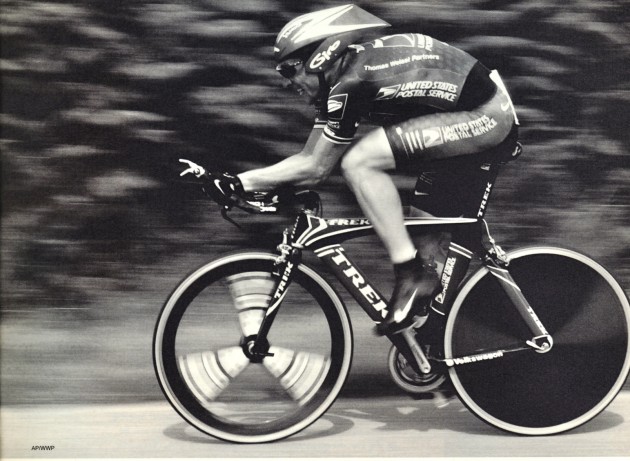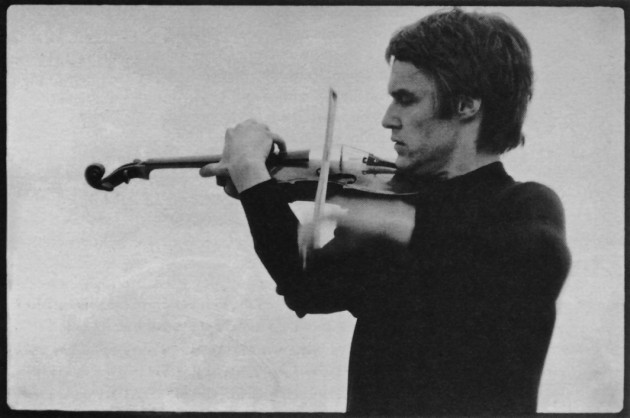[I] cycled fourteen thousand miles last year. I ride early each morning before work and on Sundays devote myself to an arduous, cleansing hill climb followed by a two-hour nap—I am long past forty, and to be honest, on Sundays it is not me who takes the nap, but the nap that takes me. In the cycling world, riders who have seen their fortieth birthday come and go are called Masters. I do not think this has anything to do with our ability to win races. Younger riders possess the advantage here. Rather, I think Masters are so designated by virtue of their experience, for having discovered something essential about their discipline.
It’s like this: you are approaching the end of a steep descent of your local summit. The last eight miles are new tarmac. Your bicycle feels as unequivocal as clockworks and as light as the skeleton of a bird. Your breath is even. Your heartbeat is strong and slow. The blood courses boldly through your veins. Your muscles are pumped. Your joints feel oily. You easily achieve fifty miles per hour. Hunkered down in the drops, pulling high gear, you lean through the sweeping curves. Focus is acute. Your mind pours its contents from your brainpan into the hollow between your ribs and stomach, and you are no longer thinking, merely feeling. Your pedal stroke flows to the wheel and the wheel flows to the road and the road flows through you, informing the stroke of your pedal. You have become momentum. You have become the moment, and in that moment you are both cause and effect.
I am not a practicing Buddhist, and yet the classical literature of Buddhism, especially Zen Buddhism, provides me with a language I find useful because I share with Zen an understanding about experience that at first glance appears mysterious, even mystical, but which is in fact very pragmatic.
To me, experience is essential—all explanations either before or after the fact of experience are merely accidental. Thomas Merton expressed it thus: “Zen… aims at a kind of certainty: but it is not the logical certainty of philosophical proof, still less the religious certainty that comes with the acceptance of the word of God by obedience of faith. It is rather the certainty that goes with an authentic metaphysical intuition, which is also existential and empirical.”
A word that fits Merton’s definition is mastery, and it is not a coincidence that disciples of Zen who have achieved the certainty to which he alludes, an intuition that is spiritual and transcendental and yet strikes decisively at the very heart of the physical world, are referred to as Masters. Nor is it a coincidence that those who have achieved the same kind of certainty in more obviously practical fields are also called masters: master mariner, master craftsman, master cyclist, master of arts.

Mastery is very hard to pin down. It is concrete in the sense that it must be expressed through the medium of the master’s chosen discipline, but it is also fluid in the sense that its identification will not bear specific attributes. For example, a master cyclist does not necessarily win every race. A master mariner does not possess explicit knowledge of the sea that can be written down. Nor does a master craftsman reveal his mastery through the perfection of the objects he produces, excessive perfection exhibiting—as do endlessly reproducible manufactured objects from which the master’s hand is evidently absent—that which we recognize as being barren of craftsmanship.
In this sense, mastery, or the results by which we identify it, may be said to be unnecessary. And by unnecessary I do not mean without bearing on the world in which we live. Rather, I mean unnecessary in the sense Gertrude Stein proposed in What Are Master-pieces and Why Are There So Few of Them when she stated that masterpieces (the results by which we identify mastery) must be unnecessary: “… a master-piece has essentially not to be necessary, it has to be that is it has to exist but it does not have to be necessary it is not in response to necessity… because the minute it is necessary it has in it no possibility of going on.”
I believe that what Gertrude Stein meant by unnecessary is this: in the discipline of logic, necessary describes attributes that are determinative, which must pertain in order for something to be categorized in a certain way. To be unnecessary, for Stein, was to be free of the constraining attributes that seek to narrowly define what something is, that endeavor to categorize it, that reduce it to a formula—in a sense, to be unnecessary meant to be a-logical. Formulas, ideal forms, are constructs of the intellect, and while events or unique objects such as works of art or craftsmanship resemble their respective ideal forms to some degree (as Plato taught us), nevertheless the forms do not exist in the world with them. What Gertrude Stein meant when she said that masterpieces must not be necessary is that they must be products of the unfettered intuition, not of the cloning intellect.
So it is with mastery, which must be unnecessary because it is essentially intuitive, the product of a refined consciousness of the existential and empirical world, a world of unique events, not of forms. The Zen master communicates this mastery to his disciple when he, providing instruction in the time-honored Zen fashion, deals him a blow on the side of the head. The disciple demands to know the formula for mastery, but the master will not respond with anything less than its essence.
Q: “Oh venerable Master, what is mastery?”
A: Smack (event).
The unutterable confidence of Zen reveals mastery in an unequivocal light, and this, ironically, is what lends it an air of mystery. Many of us who live in a Modernist world that is complex by definition are prone to assume that what is certain must also be impenetrable. Zen recognizes that human experience embraces both simplicity and complexity, and that what is mystifying is not experience itself, but our endeavors to provide an explanation of it. If this sounds glib, I will concede the point and try a different approach—because I am not a Zen Buddhist.
I have been rereading David Pye’s classics, The Nature and Art of Workmanship and The Nature and Aesthetics of Design, in which he examines in painstaking detail the fundamental attributes of what we call craftsmanship.
David Pye’s early training led him to become an architect of wooden buildings, a vocation interrupted by the Second World War, during which he enlisted in the British Royal Navy. Characteristically, Pye could optimistically discern the ripe fruit of creation even among the destructive weeds of war, and he cultivated during those years a lifelong interest in naval architecture. With the fall of the Axis powers and war’s end, he assumed a position at the Royal College of Art in London, which he held until his retirement in 1974. There, he designed furniture for industrial production, wrote his two influential books (and a third, entitled Ships), and nurtured the cause of quality in manufacture against the day when its moral significance might be unearthed like a jewel from the tomb of a decadent industry consecrated in the name of profit margin.
In addition, Pye was a consummate craftsman, a master, and his writing resonates with deft, firsthand observations and insights about the nature of craftsmanship. In fact, he disliked the word, preferring “workmanship” instead. He allowed that “workmanship of the better sort is called, in an honorific way, craftsmanship,” but repudiated the latter term because “nobody… is prepared to say where craftsmanship ends and ordinary manufacture begins. It is impossible to find a generally satisfactory definition for it in face of all the strange shibboleths and prejudices about it which are acrimoniously maintained.” Craftsmanship, he concluded succinctly, “is a word to start an argument with.”

He likewise shied away from the idiomatic application of the word “crafts,” which he felt had suffered an unfortunate mutation in the fallout of the Arts and Crafts movement of the 19th century. According to Pye, people had come to reductively associate crafts with “hairy cloth and gritty pots.” “Definitions and terminology,” he asserted in The Nature and Art of Workmanship, “are crucially important… [they] are the only possible basis for communication and we must have them.” The genius of Pye’s work lay in his systematic analyses of terms that have come to be used with haphazard disregard for their most effective applications, like using hammers to drive screws.
In The Nature and Art of Workmanship, Pye divided workmanship into two distinct categories: the workmanship of risk and the workmanship of certainty. At one end, the workmanship of risk embraces work that relies utterly on care, judgment, or manual dexterity. At the other, the workmanship of certainty relies on devices that assure a desirable result without care, judgment, or manual dexterity. He accorded to all acts of workmanship constituent degrees of risk and certainty, as when a workman uses hand tools that are self-jigging, that in some way guide themselves: a panel saw, a paring chisel, a hand plane, an adze. And he was careful to note that all workmanship of certainty has relied at one time or another upon the workmanship of risk, as manufacture relies on die-making, for example, the dies used to stamp out identical forms in the manufacturing process having initially been carved by hand and by eye. I should add that when David Pye spoke of the workmanship of certainty he did not mean to evoke the pragmatic confidence of true mastery, but to figuratively attribute to products of the manufacturing process the certainty of a deft touch.
Harnessing this basic dichotomy to his thesis, Pye plowed the fertile notion of quality in workmanship. What exactly constitutes quality in that which we produce or buy? What is the designer responsible for and what remains to the workman who interprets his designs in material form? What qualities constitute quality, and what about them are desirable or undesirable—or both, for that matter, desirable and undesirable being largely matters of taste? Pye nearly always hit the nail squarely, and he was eminently quotable:
“Highly regulated workmanship shows a thing done in style: an evident intention achieved with evident success. It is anti-sordid, anti-squalid and contributes to our morale.”
“Bad workmanship is a matter of making mistakes through hurry, carelessness or ineptitude, which thwart the design: or else of making things look equivocal independently of the design.”
Pye’s analyses defined and then illuminated the nature of craftsmanship, providing a foundation for technique.
However, mastery is not merely technique, which can be taught—monkey see, monkey do— although in matters of craftsmanship technique is necessary. It is necessary in the sense that it is the mechanism by which craftsmanship is expressed. And it is necessary in the sense coined by Gertrude Stein in her essay on masterpieces. Technique is a necessary condition of craftsmanship and is therefore not what craftsmanship is, for if craftsmanship was merely a matter of technique, it would be definable, static, and would have in it “no possibility of going on.” David Pye demonstrated that in fact craftsmanship is not static. It was his contention that in a world more and more reliant on manufacture true craftsmanship is fading, and that if craftsmanship could fade it could also become more sharply defined.
In his books, David Pye attempted just such a definition. He did not entirely succeed, as I am sure he would be the first to admit, for true craftsmanship is mastery, and mastery, as any novice craftsman will tell you, is a matter of mystery—and “mystical knowledge” cannot be conveyed by words alone. Consider this passage from The Nature and Art of Workmanship: “… workmanship is the exercise of care plus judgment plus dexterity [which] can be taught, but never simply by words.” Likewise, mystical knowledge is that which cannot be learned from words alone. It is knowledge that is revealed, which is to say, that can be gained only by experience, by performing and repeating over and over certain relevant directives. There is nothing a master of any discipline, spiritual or practical—there is nothing a master can say that will convey to his apprentice the so-called secret of expertise. The apprentice must practice his chosen discipline, must perform its injunctions until (with no certain guarantee) he acquires mastery.
Ken Wilber, speaking about Zen training, wrote:
“Words without injunctions are meaningless. Words without injunctions have no means of verification whatsoever… And, much more to the point, even if [mystical knowledge] could be stated in words—and in fact, [it] most definitely can be stated in words, because Zen masters talk about it all the time!—nonetheless, it would make no sense whatsoever to anybody who has not also performed the injunction[s].”
To the Zen novice—as to the apprentice craftsman who, observing a paper-thin shaving issuing unbroken from the master craftsman’s plane, pleads, “How did you do that, what’s the secret?”—the master can only reply: “If you want to know, you must do.”
 Yet, I submit that there is nothing truly mystical about “mystical knowledge.” Indeed, mystical knowledge is nothing less, or more, than common knowledge, except—and it is a big except—that it is common only to those who have taken skillful means into their own hands.
Yet, I submit that there is nothing truly mystical about “mystical knowledge.” Indeed, mystical knowledge is nothing less, or more, than common knowledge, except—and it is a big except—that it is common only to those who have taken skillful means into their own hands.
How, then, may we set ourselves on a path toward mastery? The guidance of a master is probably necessary, but even he or she can do no more than demonstrate the way. Pressed by his keen apprentice, whose intellect demands a procedure to follow, the master may respond to the student’s “how” with an equivocal “somehow.” The apprentice, sensing an evasion, will find this far from satisfactory. And yet, the disciple’s disappointment constitutes his first lesson, though he may not think he has been taught anything useful. For, although the disciple’s desire to know how mastery is acquired is meaningful, it assumes first—as desire always does—that desire may be satisfied, and second that the question “how,” which arises from the methodical intellect, may be answered methodically by the intellect.
The master’s evasiveness is, in fact, an expression of truth. He knows what the apprentice has yet to discover for himself: that it is not his answer, but the question itself that is equivocal. The master knows that dissatisfaction is not the effect of the student’s thwarted desire to know any more than satisfaction would be the effect of his desire fulfilled, for satisfaction and dissatisfaction are desire’s identifying traits, its fellow travelers, not its destination. The true master knows that desire is not the path that leads to mastery. Indeed, erasing the necessity of either satisfaction or dissatisfaction denies desire its biaxial identity and nullifies it entirely, revealing it to be a road to nowhere. Desire only leads back to itself.
Likewise, the intellect, which demands a cohesive answer to the question “how,” does not lead to mastery but is the disciple’s constant companion. It informs him at every step. Still, the intellect cannot supersede itself. It can point toward, but it cannot know that which lies beyond its ken. The intellect understands forms; it even understands the path upon which the disciple desires to embark. But, as in the Zen maxim that warns the disciple against confusing his finger for the moon at which it points, we must not mistake the intellect for the master’s path.

Does this sound esoteric? Almost certainly. And yet, there is nothing truly mystifying about mastery. Mastery, like all endeavors that seek first to illuminate and then refine the human spirit, is a matter of common sense. Attention to ordinary experience is the path that leads to mastery, the only path, and discipline is the stride of its wayfarer. In Zen, the word is kufū, “training,” and training means nothing more or less than applying oneself conscientiously and assiduously. In matters of intellect or desire, which fix their hopeful eye upon a specific goal or object, the path may be prescribed, but where individual experience is both the means and the end, as in the attainment of true mastery, no such prescriptions can apply. Its single maddening paradox is that there is nothing to be achieved in the usual sense. Eight hundred years ago, the Zen master Dogen explained it thus: “To learn something is to know yourself.” The master knows that he does not follow the path of mastery in pursuit of a goal, be it achievement or reward. Although these may be necessary to propel the novice headlong down the unknown (and unknowable) highway of his discontent, the true master knows that he doesn’t know what he will find. He knows only that he—and no one else—will be there when he arrives, and that he is expected.



